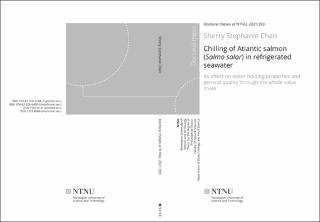| dc.contributor.advisor | Lerfall, Jørgen | |
| dc.contributor.advisor | Jakobsen, Anita Nordeng | |
| dc.contributor.advisor | Roth, Bjørn | |
| dc.contributor.advisor | Jessen, Flemming | |
| dc.contributor.author | Chan, Sherry Stephanie | |
| dc.date.accessioned | 2021-12-20T14:30:08Z | |
| dc.date.available | 2021-12-20T14:30:08Z | |
| dc.date.issued | 2021 | |
| dc.identifier.isbn | 978-82-326-6490-0 | |
| dc.identifier.issn | 2703-8084 | |
| dc.identifier.uri | https://hdl.handle.net/11250/2835143 | |
| dc.description.abstract | Water holding properties, including drip loss and water holding capacity, are important fish quality parameters. Superchilling is a preservation method prolonging the shelf life of food, where products are stored at subzero temperatures. An alternative fish slaughter method has been introduced in recent years, where fish are directly slaughtered onboard a vessel and superchilled in refrigerated seawater (RSW) at subzero temperatures during transportation. This vessel is currently the first-of-its-kind. Therefore, how this method affects the water holding properties and general quality through the whole value chain of Atlantic salmon is not fully studied.
The main objective of this thesis was to examine the water holding properties of Atlantic salmon with RSW storage at subzero temperatures through two value chains: 1. from whole fish to cold-smoked and vacuum packaged fillets; 2. from whole fish to portioned and packaged fresh fillets. This method was compared to the conventional method of ice storage. In addition, the effect of the two whole fish storage methods combined with different packaging techniques (vacuum skin, traditional vacuum) was studied on raw fillet portions. Finally, a physics-based mathematical model on heat and mass transfer was developed to predict the water and salt uptake after dry salting and cold-smoking. This model was validated with experiments and compared with a previous empirical model. Results from the mathematical model were also used as input parameters for further simulation of water activity, validated with experimental values.
Overall, this thesis presents the notion that RSW storage increases water and salt uptake and provides good water holding properties. Therefore, it is a feasible method for fish transportation, giving good quality salmon as those on ice. Furthermore, slaughtering fish onboard a vessel and RSW-superchilling condenses the traditional three handling steps, where fish are usually pumped into well-boats and transported to land before processing, into only one. This potentially introduces advantages like quicker cooling and the ability to store large volumes of fish that could be widely implemented with a possibility in a logistical shift of slaughter from land to sea. In addition, introducing numerical modelling into this study provides opportunities to strengthen and expand this tool for other industrial applications and process optimization. | en_US |
| dc.language.iso | eng | en_US |
| dc.publisher | NTNU | en_US |
| dc.relation.ispartofseries | Doctoral theses at NTNU;2021:393 | |
| dc.relation.haspart | (I) Chan, S. S., Roth, B., Jessen, F., Jakobsen, A. N., & Lerfall, J. (2021). Water holding properties of Atlantic salmon. Comprehensive Reviews in Food Science and Food Safety, 2021, 1-22. DOI 10.1111/1541-4337.12871. | en_US |
| dc.relation.haspart | (II) Chan, S. S., Roth, B., Skare, M., Hernar, M., Jessen, F., Løvdal, T., Jakobsen, A. N., & Lerfall, J. (2020). Effect of chilling technologies on water holding properties and other quality parameters throughout the whole value chain: From whole fish to cold-smoked fillets of Atlantic salmon (Salmo salar). Aquaculture, 526, 735381. DOI 10.1016/j.aquaculture.2020.735381. | en_US |
| dc.relation.haspart | (III) Chan, S. S., Roth, B., Jessen, F., Løvdal, T., Jakobsen, A. N., & Lerfall, J. (2020). A comparative study of Atlantic salmon chilled in refrigerated seawater versus on ice: from whole fish to cold-smoked fillets. Scientific Reports, 10, 17160. DOI 10.1038/s41598-020-73302-x. | en_US |
| dc.relation.haspart | (IV) Skare, M., Chan, S. S., Handeland, S., Løvdal, T., Lerfall, J., & Roth, B. (2021). A comparative study on quality, shelf life and sensory attributes of Atlantic salmon slaughtered on board slaughter vessels against traditional land-based facilities. Aquaculture, 540, 736681. DOI https://doi.org/10.1016/j.aquaculture.2021.736681 | en_US |
| dc.relation.haspart | (V) Chan, S. S., Rotabakk, B. T., Løvdal, T., Lerfall, J., & Roth, B. (2021). Skin and vacuum packaging of portioned Atlantic salmon originating from refrigerated seawater or traditional ice storage. Food Packaging and Shelf Life, 30, 100767. DOI 10.1016/j.fpsl.2021.100767 | en_US |
| dc.relation.haspart | (VI) Chan, S. S., Feyissa, A. H., Jessen, F., Roth, B., Jakobsen, A. N., & Lerfall, J. (2022). Modelling water and salt diffusion of cold-smoked Atlantic salmon initially immersed in refrigerated seawater versus on ice. Journal of Food Engineering, 312, 110747. DOI 10.1016/j.jfoodeng.2021.110747 | en_US |
| dc.title | Chilling of Atlantic salmon (Salmo salar) in Refrigerated Seawater. Its effect on water holding properties and general quality through the whole value chain | en_US |
| dc.type | Doctoral thesis | en_US |
| dc.subject.nsi | VDP::Matematikk og Naturvitenskap: 400::Zoologiske og botaniske fag: 480 | en_US |
